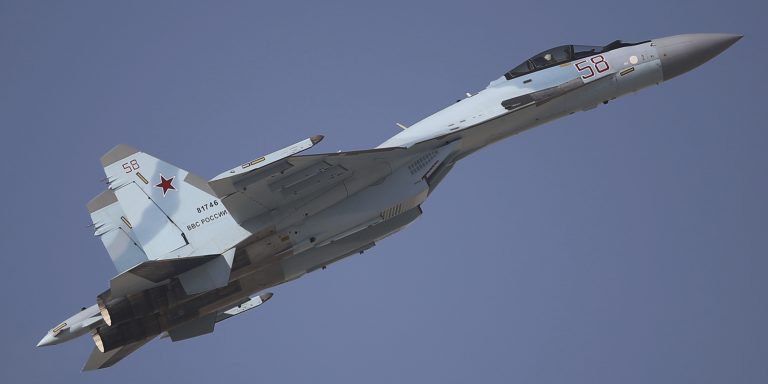INTELBRIEF
March 9, 2018
TSC IntelBrief: The Booming Business of War

- In 2017 both the United States and Russia set records for arms sales, with 2018 on target to break them.
- The U.S. is by far the largest arms dealer globally, selling $41.9 billion in 2017.
- Some long-time U.S. allies—among them Turkey, the UAE, and Qatar—are increasing their purchases of Russian arms, including advanced missile systems.
- The Trump administration has relaxed rules on Foreign Military Sales and openly states that increasing U.S. arms sales is a national priority.
The combination of persistent conflicts, a sense of shifting regional and global power dynamics, and two governments eager to sell their military hardware has resulted in a dramatic increase in global arms sales. In 2017, both the United States and Russia set records for the sale of their respective military hardware; 2018 will likely exceed those records. Each country is aggressively promoting arms exports: the U.S. government is approving Foreign Military Sales (FMS) to countries from Ukraine to Bahrain, while Russia is reaching deals to sell advanced military systems to Turkey, the United Arab Emirates (UAE), Qatar, and Egypt. Some countries are buying systems from both as a way of hedging their military and geopolitical bets.
The Middle East remains the most important region for both countries’ arms sales. In 2017, the U.S. sold $22 billion in arms to countries in the Near East and Central Asia. For its part, Russia has, in essence, turned its military support for the Assad regime in Syria into a horrific showcase for its planes and missile systems. The UAE is now considering buying ten or more of Russia’s advanced Sukhoi Su-35 fighter. The Middle East accounted for 20% of Russian arms sales in 2017, a figure that will only grow in 2018. Russia has signed massive deals with Riyadh, to include the S-400 anti-aircraft missile system, a system Russia has been featuring in Syria. Turkey has also purchased the S-400 from Russia, a remarkable move by a NATO member.
Speaking at a meeting of government and military industry officials on March 5, Russian President Putin stated ‘the scope of our military-technical cooperation keeps growing in geographic terms steadily. The number of partners has already exceeded one hundred countries.’ He also explicitly said that the Syrian conflict has shown the value in Russian military systems, saying ‘Russia will be actively developing military-technical cooperation with all interested countries, including in most high-tech segments - on those armaments for aviation, air defense, land troops and the Navy that have demonstrated their utmost efficiency during the Syrian operation.’
Countering Russian arms sales is a priority for the U.S. The U.S. tries to sell whole systems and the concept of interoperability between allies, essentially a ‘plug and play’ capability for multinational systems. This is a significant factor as to why the Turkish purchase of the Russian S-400 is so troubling for fellow NATO members, as the S-400 was specifically designed to counter NATO aircraft. U.S. arms sales include those that are financially significant—the U.S. sold $112 billion in weapons to Saudi Arabia from 2008-2016—to the geopolitically symbolic, such as the March 1 approval to sell $47 million in Javelin Missiles to Ukraine. The Javelin is a ‘fire and forget’ anti-tank missile that costs $246,000 per missile and will be of great value for Ukraine in its four-year-long conflict with Russian-supported separatists in the eastern part of the country. The Trump administration has relaxed rules on Foreign Military Sales and openly states that increasing U.S. arms sales is a national priority.
2018 is trending toward another record-breaking year for arms sales. The U.S. is pushing its extremely expensive F-35 fighter as the ‘fighter of the future,’ while Russia is promoting its SU-57 5th generation fighter the same way—though it is still in pre-production, while the F-35 is on the market. India, a vital financial partner in the development of the SU-57, has recently engaged the U.S. in talks about the F-35, a move that would hamper if not cripple the full development of the SU-57. Russia recently used two of the stealth fighters in a high-profile bombing run in Syria, again using that conflict to showcase weapons for their weapons market. The sale of missile systems such as the Patriot—and the much more advanced Terminal High Altitude Area Defense (THAAD)—will increase in step with the growing threat of offensive missiles, including intermediate ballistic missiles.
.
For tailored research and analysis, please contact: info@thesoufancenter.org
[video width="960" height="540" mp4="https://thesoufancenter.org/wp-content/uploads/2018/03/Final-Edit-1-147.mp4" poster="https://thesoufancenter.org/wp-content/uploads/2018/03/AP_17317441328116.jpg"][/video]